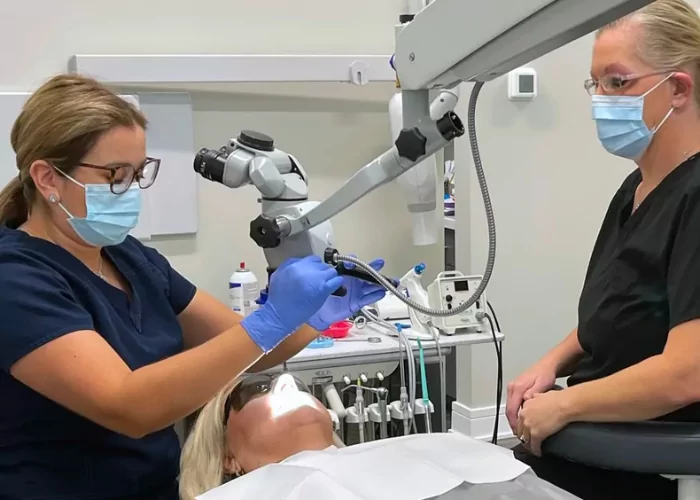About Endodontic Retreatment
Like root canals, endodontic retreatments are common, non-surgical procedures. However, due to the nature of removing dental repair materials such as fillings and crowns before beginning, retreatments come with greater complexity. So, even if you had a dentist perform a root canal, you may need to see an endodontist for retreatment. Endodontic practices have special tools for seeing inside the tooth, such as surgical microscopes and cone beam CT scanners, to improve patient outcomes and reduce complications.
Endodontic retreatment may resemble the process of a root canal, but it includes additional steps the doctor takes to reach the tooth. First, the endodontist will take images of your tooth either with a three-dimensional CT scanner or digital x-rays. The imaging helps the endodontist to see your tooth’s problem before removing any dental work on it.
Next, the endodontist will need to reach the interior of the tooth. To do this, they will carefully remove a portion of your crown and filling. Cleaning out the canals again removes any bacteria that may have remained after your first root canal or entered later.
At Southwest Endodontics, we use Gentlewave technology to help clean out the canals of teeth during root canals and retreatment. The advantage of this tool is the ability to reach deeper into the tooth than standard tools can and to reduce the chances of leaving untreated areas.
Once the doctor feels certain that they’ve fully cleaned the canals, they reseal and fill the tooth. If you had a crown on the tooth after your first root canal, you may need to go back to your dentist to get the crown repaired or replaced.
Signs That You May Require Endodontic Retreatment
If you have ever had endodontic treatment on any of your teeth, you need to continue to keep up with good cleaning of the treated teeth and those around them. Plus, knowing common signs that you may have a problem with the tooth will help you to make an appointment with an endodontist as soon as possible. The faster you can get endodontic retreatment after symptoms appear, the less pain you will experience, and the more likely you can keep the tooth.
Common signs in a previously treated tooth of needing endodontic retreatment include
- New pain after the tooth stops hurting shortly after the root canal
- Loose, lost, or damaged crown
- Fracture in the tooth
- New pain in a root canal treated tooth
- Decay in the tooth
If you or your dentist notice any of the above signs, you should schedule a visit with us at Southwest Endodontics for assessment and treatment.
Why Southwest Endodontics Should be Your Choice for Endodontic Retreatment in Orland Park IL or Geneva IL
You have several options for dental professionals around Orland Park and Geneva IL. So, why choose us at Southwest Endodontics for your retreatment?
First, we have two convenient locations to ensure that you have outstanding endodontic care in your neighborhood. Whether you are in Geneva, Orland Park, or anywhere in between, we’re close to you.
Second, we use the most up-to-date technology for endodontic care. For instance, in endodontic retreatment, we have CT scanners to give our doctors a three-dimensional look inside your tooth. We also have Gentlewave technology, which cleans out your canals, even the tiniest, hardest-to-find areas painlessly and effectively.
We have a team of experts in endodontics who can help you to save a tooth. In fact, if you don’t get retreatment soon, infection inside the tooth could lead to the bone wearing away. Waiting too long for care could mean that your only remaining option is extraction. If you want to keep your teeth, schedule endodontic care when you need it. It can be the only way to save a tooth with deep decay or internal infection.
Let Us Help You Keep Your Teeth with the Exceptional Endodontic Retreatment Orland Park IL and Geneva IL Residents Demand
You don’t have to lose a previously treated tooth due to reinfection or damage. Our endodontists will determine if endodontic retreatment is the best solution to treat your tooth to save it. With endodontic care, you avoid needing to have teeth pulled, helping you to keep a healthy, great-looking smile for life. Reach out to us at Southwest Endodontics to schedule a visit for an exam at our Geneva or Orland Park location.


